| Columns Retired Columns & Blogs |
"The Heat Is On" ........... Glenn Frey :-) ............
Before performing any measurements, I ran one Pass Labs XA200.8 (serial no. 29556) for an hour at one-third its measured maximum power into 8 ohms—thermally, the worst case for an amplifier with a class-AB output stage but not for a true class-A amplifier, which runs at its hottest with no signal. By the end of the hour, the top panel was warm, at 99.4°F (37.4°C), and the side-mounted heatsinks were hotter, at 118.1°F (47.8°C). Although Pass Labs specifies the XA200.8 operating in class-A, I suspect that even with its massive heatsinking, the amplifier doesn't have sufficient bias current to allow class-A operation up to its specified maximum power.
I performed a full set of measurements using my Audio Precision SYS2722 system (see the January 2008 "As We See It"). The voltage gain at 1kHz into 8 ohms was slightly lower than the specified 26dB, at 24.85dB for the balanced input and the expected 6dB lower for the unbalanced input (for unbalanced drive, sockets 1 and 3 of the XLR jack were connected with a jumper). The amplifier was non-inverting (ie, it preserved absolute polarity) with both inputs. Its balanced input impedance was the specified 100k ohms at 20Hz and 1kHz, dropping slightly to 93k ohms at 20kHz. The unbalanced input impedance is specified as 50k ohms; my estimate was 55k ohms at 20Hz and 1kHz, 38k ohms at 20kHz.
The XA200.8's output impedance was 0.11 ohm at 20Hz and 1kHz, rising to 0.15 ohm at 20kHz. The modulation of the amplifier's frequency response, due to the Ohm's law interaction between this source impedance and the impedance of our standard simulated loudspeaker, was just ±0.1dB (fig.1, gray trace). Into an 8 ohm resistive load (fig.1, blue trace), the XA200.8's response was flat up to 20kHz, then rolled off to reach –3dB around 120kHz. The response rolled off a little earlier into lower impedances, but was still just 0.5dB down at 20kHz into 2 ohms (red trace). With this wide a small-signal bandwidth, the amplifier's reproduction of a 10kHz squarewave into 8 ohms featured short risetimes and a well-squared shape (fig.2).
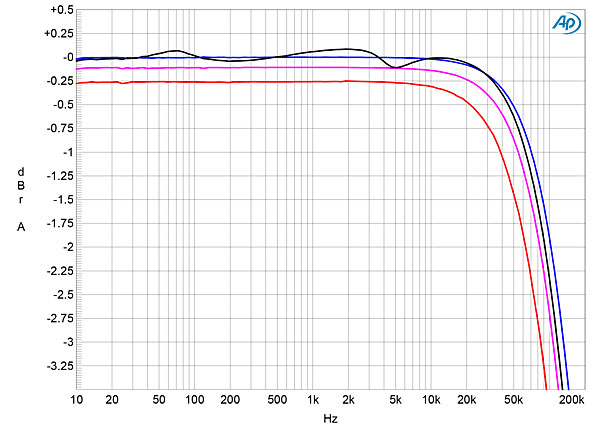
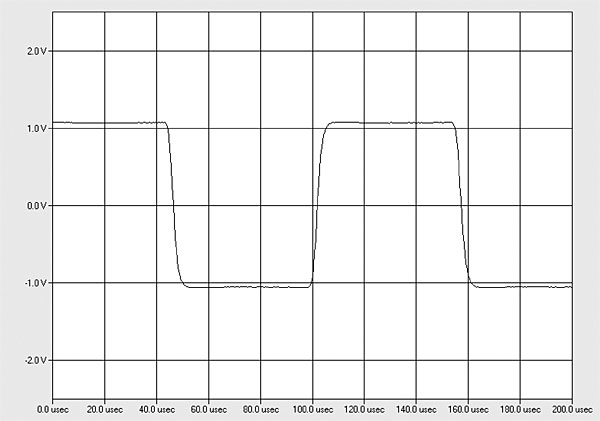
The unweighted, wideband signal/noise ratio, ref. 1W into 8 ohms and taken with the input shorted to ground, was an excellent 83dB. This improved to 88.2dB when the measurement bandwidth was restricted to the audioband—and was even better, at 92.1dB, when the measurement was A-weighted. Like the other Pass Labs amplifiers we have reviewed, the XA200.8 is quiet. As with the XA60.8 monoblock that we reviewed in December 2017, both the odd and even harmonics of the 60Hz power-supply frequency were present in the amplifier's noise floor, though these all lay at or below –100dB ref. 1W into 8 ohms (fig.3).
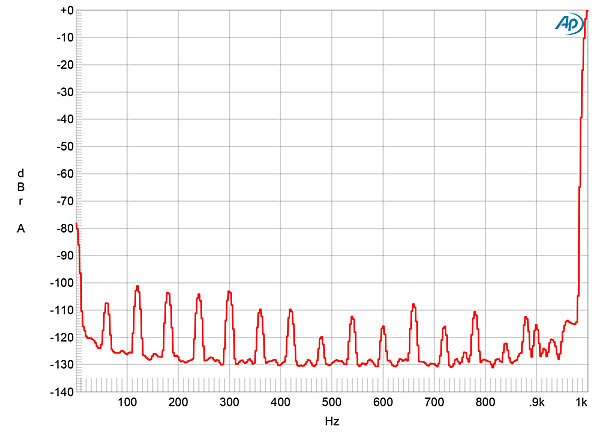
The XA200.8 is specified as delivering 200W into 8 ohms (23dBW). Using our definition of clipping—ie, when the output's percentage of THD+noise reaches 1%—the Pass Labs amplifier clipped at 258W into 8 ohms (24.1dBW, fig.4), 480W into 4 ohms (23.8dBW, fig.5), and 700W into 2 ohms (22.4dBW, fig.6). The THD begins to rise above the noise floor at powers greater than a couple of watts, but remains at or below 0.1% below 100W into any of these impedances. As with the XA60.8, the percentage of THD+N in the XA200.8's output slowly rises with increasing power, suggesting that the amplifier uses only a small amount of corrective feedback.
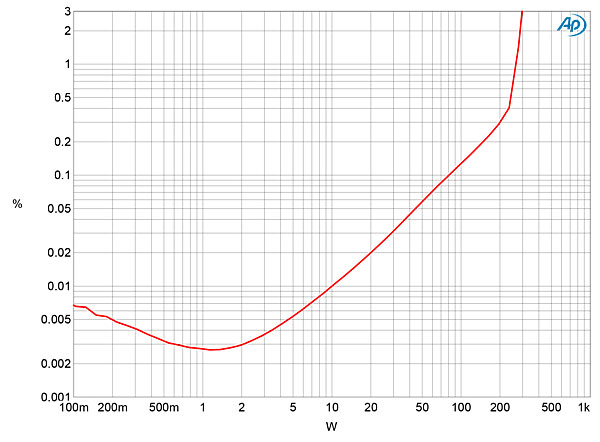
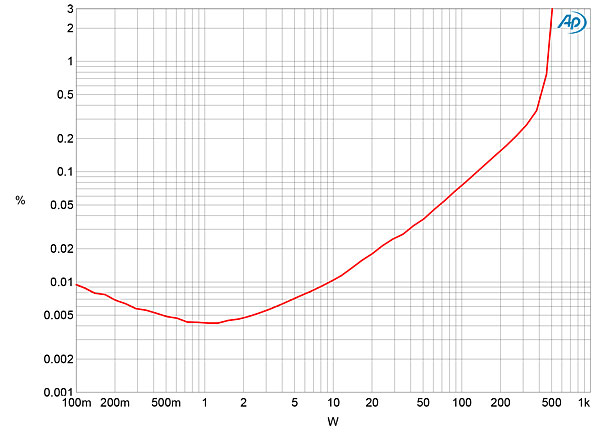
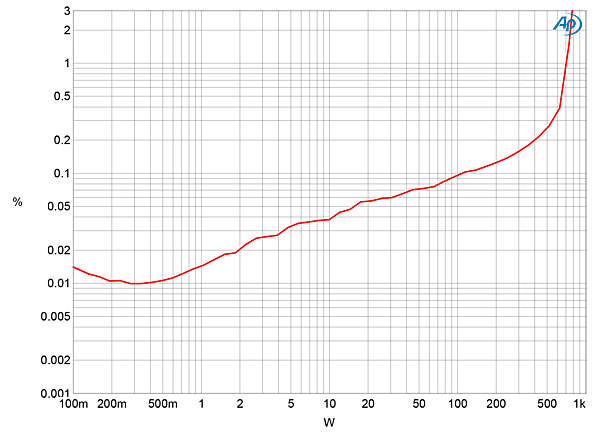
I examined how the percentage of THD+N changed with frequency at 20V, which is equivalent to 50W into 8 ohms, 100W into 4 ohms, and 200W into 2 ohms. The THD+N was extremely low in the midrange into 8 and 4 ohms (fig.7, blue and magenta traces), and still below 0.1% into 2 ohms (red). It rose linearly as the frequency increased, the three traces converging in the high treble—which suggests that, again like the XA60.8, the circuit has limited open-loop bandwidth.
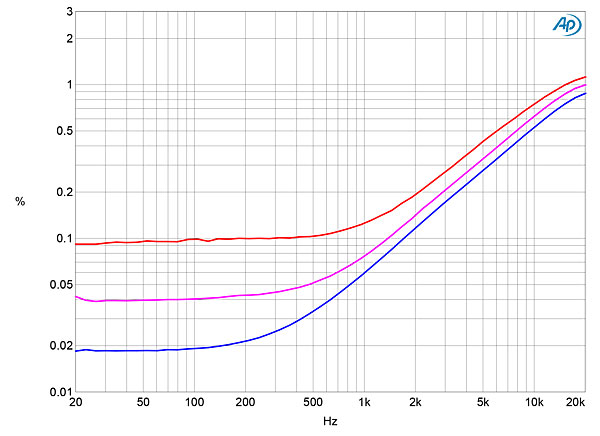
Fortunately, the XA200.8's distortion is predominantly the subjectively innocuous third harmonic (figs. 8 and 9). Still, at low frequencies into lower impedances, the second harmonic rises to equal the level of the third, and some higher-order harmonics appear (fig.9), though the latter all lie at or below –100dB (0.001%).
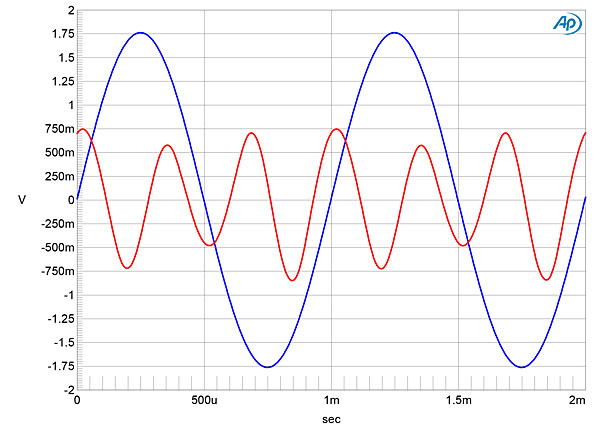
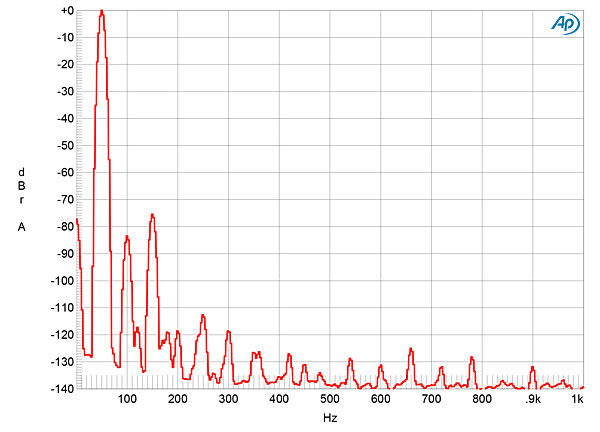
As with the other Pass Labs XA-series amplifiers we have reviewed, the XA200.8's top-octave decrease in linearity (fig.7) is associated with some higher-order intermodulation products that were fairly high in level when the amplifier was asked to drive an equal mix of 19 and 20kHz tones at high power into 4 ohms (fig.11). Even so, the second-order difference product at 1kHz, which will be more audible than the higher-order products, lies at a low –74dB (0.05%).
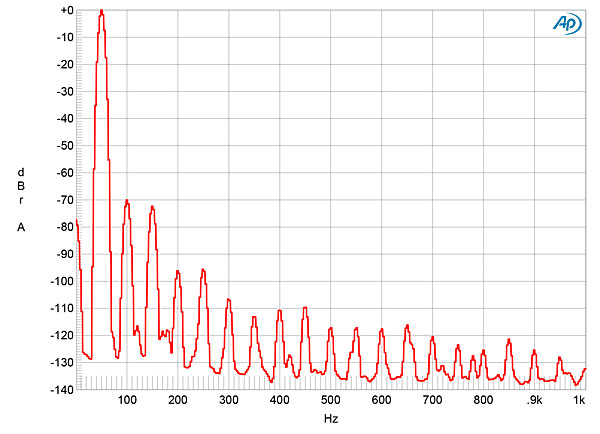
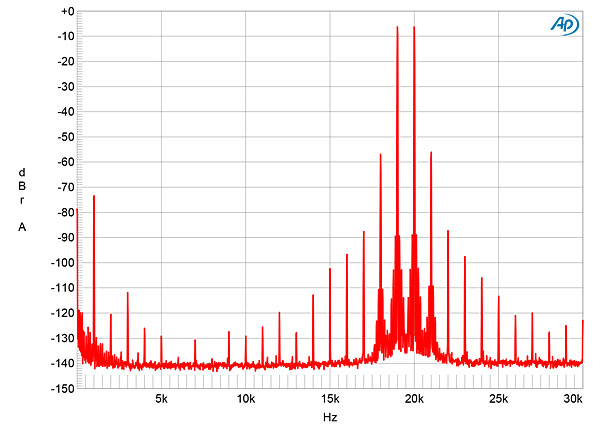
The measured performance of the Pass Laboratories XA200.8 reveals some well-balanced audio engineering.—John Atkinson

"The Heat Is On" ........... Glenn Frey :-) ............

How do we use the measurements to determine the dynamic range in bits for an amplifier?

How do we use the measurements to determine the dynamic range in bits for an amplifier?
1 bit is equivalent to a dynamic range of 6.02dB. So you could say that an amplifier that has a S/N ratio ref. full power of 96dB has an effective resolution of 16 bits.
John Atkinson
Editor, Stereophile

So with a S/N of 88.2 dB for the audible bandwidth, this amp has less than 15 bits of dynamic range ref. to 1W into 8 ohms. I'm not trying to be contentious, just trying to get this straight in my head. We don't know what the S/N is for full output power, correct?

We do not know the noise at the full power but we know the THD at full power. In fact, if we have 1% THD, we have 7 bits. But we must to be rational to see the truth: at this power(258w in 8ohm), how many bits will you hear ? Which will be the "THD level" of the room ? In fact, each criterion taken separately does not tell us how nice music will sound. Listening the tested device at home is a must.

When you measure an amplifier's performance, do you do it "straight out of the wall," or in the context of the power conditioners that are used to feed it?
I don't recall if it's ever been done, but do you ever compare an amp's performance in context of it being plugged into an after market conditioner vs. 'straight up?'
That would be exciting to see!

Mr. Atkinson, I wrote a question for you under another review which I think escaped your attention, and might be of interest to some other readers--I'd greatly appreciate it if you could reply now:
I'm interested in using either the M32 or the M22--driven directly from an NAD M51--to drive a pair of Dynaudio Special 40s. Could you possibly comment on any difference in sound quality? I understand that the power output would be different, and that one is an integrated and one is a power amp. What I'm interested in, mostly, is the difference in sound between the Hypex N-core of the M22 and the different system used in the M32.
Thank you so much. LTL

I'm interested in using either the M32 or the M22--driven directly from an NAD M51--to drive a pair of Dynaudio Special 40s.
I know from experience that the M32 does a good job driving the Dynaudio speakers. (I review the Special 40s in our September issue.) But as the M32 has a DAC and you already have the M51, the M22 might better suit your needs.
John Atkinson
Editor, Stereophile

Mr. Atkinson, I think my question was very clear: "the difference in sound between the Hypex N-core of the M22 and the different system used in the M32." I think this would be a question of interest to many readers, and I hope maybe you'll discuss it in the future. Thanks, LTL

Do you understand you are trying to compare an analog power amplifier with a pwm direct digital integrated? It is like comparing an engine to a car as the preamplifier and dac the m22 requires will influence the sound to a great degree.
My opinion is that the architecture utilized in the m32 is the better move for most users.

Thanks for your reply. My understanding was that the M22 is based on the Hypex N-core, which is a PWM module, and that the M32 is also PWM, as you note, so I'm not sure I understand why you call only one of them "analog." Of course I understand that the pre-amp and DAC will influence the sound.
Could you please expand on why you think the M32 architecture is better?
I'm also considering the PS Audio Stellar M700. Like the NAD m22, I would connect the PS Audio monoblocks directly to the NAD DAC, which has variable output.
Thank you

that scamp Steve Guttenberg is advertising for Under 40 year old Salesmen and Writers + Music review.
I hope you can give him a Stern Staring Down on behalf of all us Old Geezers who's Grandchildren haven't yet sent our "Vintage" Audio Gear to Dave Wasserman so as to Cash in their inheritance.
Pretty soon he'll be wearing a Phonak Hearing Aid Shirt instead of a Rocker's Harvey Shirt.
Thanks
Tony in Michigan

..that almost all class-a amps I’m aware of are somewhat “soft” in the bass dept. Truth be told – I’m a control freak when it comes to the base; but sometimes I wonder if this whole “tight” thing, as well as the “stage” equivalent etc, does not actually consist another convenient artifact, while my considerable "live experience" does not serve me particularly well.

" while my considerable "live experience" does not serve me particularly well."
Since I respect your opinion, could you please rephrase this so I can understand what you're trying to say? What I do know is that, in my listening experience, bass in decent symphony halls and over good club amplification systems is anything but loose, flabby, or of uncertain pitch.

..this is not always the case.

..but in fact is somewhat tautological a thought in the sense of imposing certain preconceptions of “good sound” to reality and consequently using the ensuing real/ideal fusion as a reference point for what "good sound" sould be actually like; I am inclined to call this inevitably circular interaction “the hi-end audio uncertainty principle” :-}

But wait, that could mean you're bad. If good = bad, and bad = good, then where are we? Oh dear, back to the drawing board. Now, if I could figure out what a good drawing board is....


said reality is that which persists though you have stopped believing – or something close; his love for music was also as strong as his hate for reality..

There are also, Philip K Dick awards .......... Wonder who gets the award(s) this year? :-) ............

So a pair of these amps:
Given that a pair Benchmarks AHB-2's is $6k, Devialet's most powerful amp is $19k and both of these are drastically superior in every way compared to these behemoths, why would anybody buy them?
These amps are absurd. A waste of money that keeps wasting money every minute they are powered on.

Also, PS audio Stellar amps, Stereophile class A recommended ........ Costs thousands less ......... The Sim audio amps, reviewed in recent Stereophile, weigh 300 pounds each! :-) ............

I Googled it .......... The weight of Muhammad Ali when he was the heavy weight champion was 236 pounds .... He was 6 foot 3 inches tall :-) ............. His famous quote "Float like a butterfly, sting like a bee" :-) ..........

"..., why would anybody buy them?"
Ask NP at DIYaudio.com. Maybe he can enlighten you ;-)

This would an interesting situation for comparison with speakers with different impedance 'propensities' than Wilsons. Their size mitigates against easy comparisons!
Also, perhaps all that power conditioning took its toll. Especially with regard to the adjectives about the bass, where that stuff can really turn an amp into an anchor. Did they get a chance to just play plugged right into the wall?
Power 'conditioners' aren't exactly a one size serves all kind of proposition.
It could be cumbersome to get a handle on these monsters in conjunction with the effects of Audience aR2p-TSSOX, Tweek Geek Dark Matter Stealth (with High Fidelity & Furutech options) power conditioners; Nordost QB8, 2 QX4, QK1 & QV2 AC power accessories.
That's more conditioners than at my hair stylist's!

An excellent article -JVS
which Pass Labs, 160.5, 200.5 or 200.8, did you enjoy the best?
As always, Thank You JA, for the measurements.

I have owned both the 100.5; the 160.5; the 200.5 and now the 200.8 (A serious case of Audiophile insecurity, perhaps?).
However, I fully concur that the 200.8 is the better amplifier. It surpasses the others in the XA range by far.

It can function as an amplifier, heater and BBQ grill!

"All About That Bass" ......... Meghan Trainor :-) ........

"Hot Stuff" .......... Donna Summer :-) .............

... If he were to lower the distortion of his amps to levels similar to that of the Benchmark amp, would he be able to maintain the same subjectively appealing sound quality?
Incidentally, still waiting for reviews of more recent power amps from Rotel. The $1600 (and under 40lbs. for a 2-channel unit) RB-1582 MkII can generate about 250W into 8Ω and 435W into 4Ω, according to the HiFi News test. Peak power into 2Ω is over 1kW.
If you need even more power, the RB-1590 has about double the output at about double the price and weight.

I hope you keep those Amps and use them as your Reference, .10 Cents per Kilowatt hour is pretty much a National Standard, leaving them on will probably cost about $5.00 per day. ( about $1,800 per year ). Port Townsend Air Conditioning is a nonsense thought, you need that Clean Heat from those Amps.!!
Besides, you're not wasting $100,000 Plus +++ on one of those old fashioned 33.3 rigs and all the sundry paraphernalia needed to support the very pricy Vinyl coming to you on a regular basis from Sir. Chad & friends.
Stereophile readership needs you to be a Reference Level person of Integrity, you need those Amps to properly do your job : Being Our Reference Level Audiophile, reporting on all things important ( all things "Stereophile" to me and our man in Oh'Canada ) !
Tony in Michigan

ML 536 mono-blocks, Stereophile class A cost $30k ........... ML stereo 534 cost $20k .............

I can only imagine how my recordings of Fischer and Schnabel would sound through a Pass amp like this one. In my cramped Manhattan apt my Klout will have to suffice. Paired with my SME 10, LP12, and modded 1200, I bet it would be magic, notwithstanding the irrelevant comments from some “expert” on analogue’s shortcomings from Michigan, as seen above. Thanks for letting me dream JVS and thanks for an entertaining review.

... and determine if the sound quality is also "magic".
Your Linn Klout has a rated output of 80W into 8Ω and 160W into 4Ω. According to the Stereophile test, the output of the Pass XA25 reached the clipping point (~1% THD) at 80W into 8Ω and 130W into 4Ω - not much difference. Plus, one two-channel XA25 costs only about one-tenth that of a pair of mono XA200.8 amps and weighs a much more manageable 45lbs.
https://www.stereophile.com/content/pass-laboratories-xa25-power-amplifier

XA25 may be the "best bang for the buck" in the Pass line-up ...... Stereophile class A :-) ............

So a reality check...
Does one care more about absolute bass slam than beautiful sound?
And, in a real, live, acoustic setting, does bass slam, or is it a bit soft and unfocused compared to amplified reproduction? I believe it is the latter.
So I for one, could not care less about absolute bass slam or playing music at deafening pressure levels.These are unrealistic ideals imho.
My ears find even Nelson's most modest (power related) efforts (ie: SIT 2, J2) very musically faithful and rewarding in their own way.
Perhaps we have excepted far too poor driver efficiency and poorly engineered impedance curved loudspeakers that demand these enormous power consumers/producers. Should we perhaps look back, and reevaluate our implementation? I think so.
But there will always be those who oppose unnecessary resistance with more power...
I too care more about gorgeous music

"Bang Bang" .......... Jesse J, Ariana Grande & Nicki Minaj :-) ..........

These two items should not be used together if one is seeking audiophile approved levels of SQ, especially during a review.
I've yet to find a power conditioner that did not negatively impact music transients, midrange snap, bass slam, bass depth...etc
I've owned some of the audiophile favorites in terms of power conditioners and no matter how bold the claims are from the PC manufacturer that their product doesn't limit current or in some cases believe their product has more power then the wall plug....its all BS.
Even my little Pass XA60.8's are negatively impacted using the well reviewed Shunyata Denali. Same story for the big Torus RM20.
These monster XA200.8's should never be plugged into anything but the wall directly and reviewing them any other way is doing a dis-service to your readers and potential buyers.
JVS...dont let that bad a$$ system of yours go to waste...its time to start De-Tweaking it and let the music flow as intended :)

"Although Pass Labs specifies the XA200.8 operating in class-A, I suspect that even with its massive heatsinking, the amplifier doesn't have sufficient bias current to allow class-A operation up to its specified maximum power."
If you make such a claim you should follow up on that.